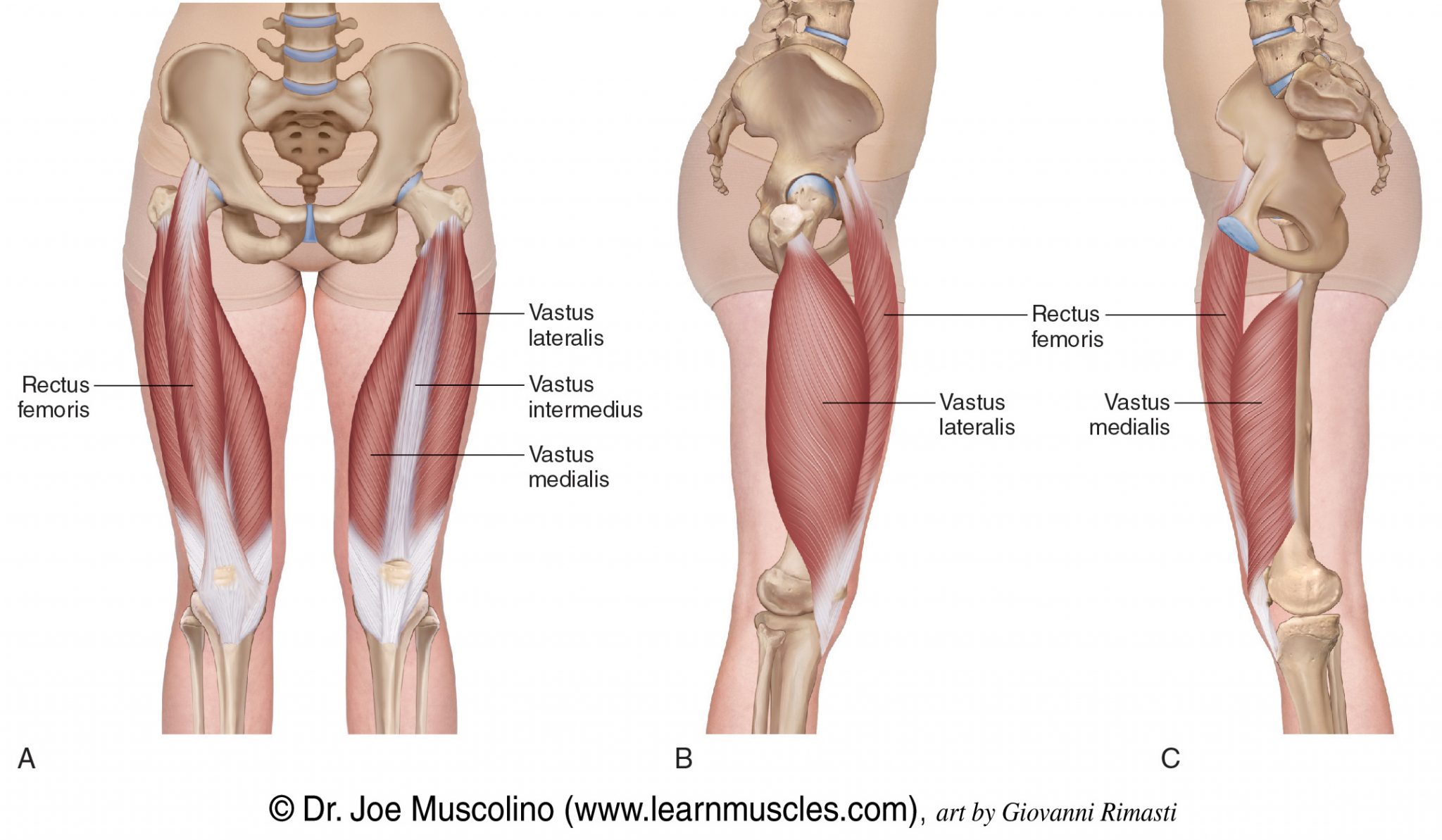The Ultimate Guide to Quad Stretching
Feb 26, 2022Brush your teeth. Drink water. Eat your greens. Stretch your quads.
If you spend any time at all stretching each week, at the top of your list should be spending 5-10 minutes on your quads.
If you’re anything like me - or rather, how I used to be - you might be sitting there thinking, “Ugh, I don’t have the time or the interest for stretching” and trust me, I hear you.
Most people either love or hate stretching, and I used to be the same. Until I experienced first hand how much better I felt and moved when my joints and muscles were mobile and resting at the right length.
And now you might be wondering, “At the right length??? What on earth does that mean?”
The illustration below gives you a better understanding of the four muscles that make up your quadriceps (“quads” for short).

Notice that the large, superficial rectus femoris muscle originates high up on the pelvis at your hip, and inserts onto your tibia bone, all the way at the bottom of your knee joint.
The first step in stretching your quads right is to understand that your hip and knee position must be addressed, so that the rectus femoris can be fully lengthened.
If this one muscle (of the four quadriceps muscles) is tight, or resting in a shortened position, it will pull on both the hip and knee joints, causing those joints to be moved out of optimal position.
More specifically, tight quads tug on your knee cap (patella) causing it to move out of alignment, often causing knee joint irritation. If you have any kind of knee discomfort, there is a very, very good chance that your quads are tight (and your glutes are weak…more on this in a minute).
Makes sense, right? Now let’s take it a step further.
You may have heard me say that tight muscles are often the result of weak muscles.
And, if you’re one of my true insiders, you might have been one of the lucky few who have heard me sing a very contorted version of The Skeleton Dance song. Ohhhh, the fun we have.
You may remember the children’s song (The Skeleton Dance) where the lyrics are along the lines of, “The foot bone’s connected to the leg bone. The leg bone’s connected to the knee bone…” and you may recall my bastardization of that song, lol.
The bones of the human body are connected to each other by joints, and your joints are connected (and aligned or misaligned) by your muscles.
If you have a weak muscle, it causes an imbalance at the associated joint. The joint then tends to become misaligned, and then you have a problem!
While stretching is important, I’ve come around to the understanding that most often, the real problem is a weak muscle. Therefore, stretching alone may not resolve your issue.
Have you ever been told that your hamstrings are tight? So you join a yoga class or start stretching your hamstrings, only to find out they never really become more flexible. After 20 years or so of seeing this, I finally caught on to the real problem. Weak muscles.
This is yet another reason why I’m obsessed with helping you use strength training to create the body you need to keep up with the life you love.
Proper strength training can resolve pretty much any issue you have. This is why I don’t stress stretching very often. There is one exception; stretching your quads daily is important.
The reason why it’s important to stretch your quads is because there is a very good chance that you have weak glutes. In 30 years of coaching women, 9 out of 10 of my clients have had weak glutes. It’s a pervasive issue with serious implications like knee pain, hip issues, low back problems, and even neck and shoulder injuries.
After 20+ years of seeing chronic problems stemming from weak glutes, I created The GLUTES Project as an effective solution.
The shortest version of today’s story is this…
Drink water, eat your greens. Strengthen your glutes and stretch your quads.
The video above will walk you through 7 variations of highly effective quad stretches. Try them all, and see which ones feel the most effective for your body.
Aim to spend 10 minutes every day (or as many days per week as possible) using the stretches in this video. Hold each stretch for 20-30 seconds in a gentle and relaxed manner. Stretching should feel good, while also being a little bit intense. Think about releasing and relaxing into a deeper stretch the longer you hold it.
A great rule of thumb for static stretching is: If the stretch intensifies the longer you hold it, you’re moving too deeply into the stretch. Ease off until the stretch sensation mellows over the length of time that you’re holding the stretch.
Love this story? Please spread the good word and share it with a friend.
Stay strong (and mobile), friend.
Become Better Than Ever
Each week you'll get free info and tips to create the body you need to keep up with the life you love. Creating your best body ever is one part effort and one part desire. With 30 years of hands-on experience I can show you the fastest and easiest way to become empowered so tomorrow you'll wake up feeling unstoppable.
Your information is safe and I'd never share it.




